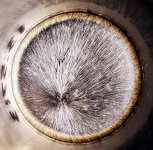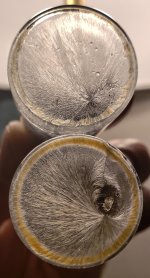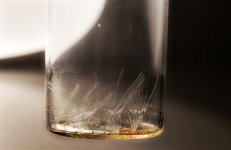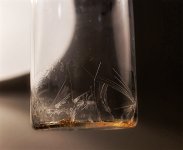Gaujac, A., Ford, J. L., Dempster, N. M., de Andrade, J., & Brandt, S. D. (2013). Investigations into the polymorphic properties of N,N-dimethyltryptamine by X-ray diffraction and differential scanning calorimetry. Microchemical Journal, 110146-157. doi:10.1016/j.microc.2013.03.009
-
Members of the previous forum can retrieve their temporary password here, (login and check your PM).
2 different melting points for DMT (polymorphism)?
- Thread starter dreamer042
- Start date
Migrated topic.
So they found two potential polymorphism of DMT, each with different properties.Investigations into... said:Abstract
The powerful psychoactive features of N,N-dimethyltryptamine (DMT) have sparked the imagination of many research disciplines for several decades. One of the key chemical features associated with compound identity is the determination of melting points. The descriptions of both melting points and morphology associated with DMT free base have long been a source of interest and discussion, especially when considering that these values encountered in the scientific literature range dramatically between 38–40 °C and 73–74 °C, respectively.
Such variations in reported melting points suggest that DMT may exist in two or more polymorphic forms and it was the aim of this study to examine the potential polymorphism of DMT via X-ray powder diffraction (XRPD) and differential scanning calorimetry (DSC), including fast scan DSC.
DMT samples were prepared following extraction from Mimosa tenuiflora inner barks or by laboratory synthesis and then its crystals were recrystallized from solutions of the alkaloid using either hexane or acetonitrile. Irrespective of source, crystals originating from synthesis were predominantly white crystals obtained using crystallization from hexane, whereas yellow samples following recrystallization with acetonitrile.
Irrespective of source or solvent, two polymorphs appeared to exist with melting points, determined by DSC, of 57 °C to 58 °C for Form I and 45 °C to 46 °C for Form II.
Estimates for their enthalpies were 91.9 ± 2.4 J g− 1 for Form I and 98.3 ± 2.8 J g− 1 for Form II. Form II converted to Form I during DSC; conversion was thus prevented by fast scanning rates of 100 °C min− 1. A transition temperature (Tg) in the range − 21 °C (2 °C min− 1) to − 13 °C (100 °C min− 1) was determined depending on DSC scanning rate.
Its closeness to the melting point indicates a tendency of Form II to convert to Form I on storage, a phenomenon that was also facilitated by grinding. This study indicates that the presence of differently colored DMT free base crystals obtained from recrystallization might also point towards the existence of polymorphs rather than just the presence of impurities.
Does this open the discussion again about the difference that people experience with different extracts, that it might be due to having different forms of the DMT they extracted?
Also this post from this thread is interesting.
Kind regards,
The Traveler
From what I understand that should not affect psychoactive effects, only physical crystallization, or in other words, how it looks (and melting point, etc).. Once it`s ingested it will not be in it`s crystal formation, will dissolve in blood and attach to receptors the same.
they're citing two different enthalpies of fusion, along with their structural characterization by spectroscopy. this would indicate different structures and physical properties (m.p.). it does not suggest differing psychoactivities.
what they didn't propose is an structural representation of the other form.
I suspect it's similar to the serotonin molecule on the Nexus homepage, sans the hydroxy.
what they didn't propose is an structural representation of the other form.
I suspect it's similar to the serotonin molecule on the Nexus homepage, sans the hydroxy.
The Traveler said:Does this open the discussion again about the difference that people experience with different extracts, that it might be due to having different forms of the DMT they extracted?
Also this post from this thread is interesting.
Kind regards,
The Traveler
..glad you spotted that Traveler
it is my understanding that in some cases of initial tryptamine crystallization (incl. DMT), betacarbolines can be present as trace impurities, but re-x results in a purer form..
this could explain subtle differences..
benzyme said:they're citing two different enthalpies of fusion, along with their structural characterization by spectroscopy. this would indicate different structures and physical properties (m.p.). it does not suggest differing psychoactivities.
what they didn't propose is an structural representation of the other form.
I suspect it's similar to the serotonin molecule on the Nexus homepage, sans the hydroxy.
I just noticed, it's a psilocin molecule.
DMT with a similar orientation, probably melts at 44-46 C. When the orientation is rotated about the alpha-carbon to 120 °, the m.p. is probably in the 57-58 C range, or as high as 67-69 C. Rotation about that bond is characteristic of amino acids like Tryptophan, and is characterized by Ramachandran plots.
Tryptamine - Wikipedia <- you can see which carbon is alpha-position
Samvidbuho
Rising Star
I have been doing some solubility tests recently and noticed that a lot of the samples exhibited characteristics of polymorphism. The sample that I held at 46C wasn't in melt, and on two occasions I was able to clearly see elevated MP temperatures - the first was a sample which began to melt at 54.1C, at 55.(~2)C there was melting in bulk and by 58.8C the sample was completely melted. The second sample began to melt at ~54.5C and was fully melted at 57.8C
The study produced several different morphologies in the end, with no clear correlation yet between those samples with the elevated MP and the shape of the dry solid. In fact, those samples each gave something different - crystals, needles, and a structure which resembles a spherulite.
There is no clear cut trend actually between any of the final forms with the testing conditions the respective sample was subjected to, and it's making my analysis difficult - the spherule shapes at first seemed to be formed from either rapid heating rates or else a rapid quench from high temperatures, but then they started appearing in samples that never got heated past 40C. I can't tell definitely if this is a polymorph but it seems so, since generally the structures are clear - to - white with a surrounding yellow amorphous portion around the bottom rim of the vial. A couple examples also seem to grow around an 'impure' inclusion which is nothing other than a small yellow crystal.
Regarding the needles, I haven't seen these before either. They are clearly different from the dendritic patterns produced from vapor along the walls of a glass, and seem to exist within some sort of temperature regime, from 36.5C - 68C in my study, with the longest needles formed at 46.0C.
I don't know how to tell for sure if these two are polymorphs or just exhibiting altered habits, but it kinda seems like polymorphism to me. The study from the article says the yellow amorphous mass is a polymorphic form, but what about these other structures.. I don't know.
I also would like to see a study which investigates polymorphism in salts, and what forms survive the conversion to freebase.
Pictures of some of these different forms below.
The study produced several different morphologies in the end, with no clear correlation yet between those samples with the elevated MP and the shape of the dry solid. In fact, those samples each gave something different - crystals, needles, and a structure which resembles a spherulite.
There is no clear cut trend actually between any of the final forms with the testing conditions the respective sample was subjected to, and it's making my analysis difficult - the spherule shapes at first seemed to be formed from either rapid heating rates or else a rapid quench from high temperatures, but then they started appearing in samples that never got heated past 40C. I can't tell definitely if this is a polymorph but it seems so, since generally the structures are clear - to - white with a surrounding yellow amorphous portion around the bottom rim of the vial. A couple examples also seem to grow around an 'impure' inclusion which is nothing other than a small yellow crystal.
Regarding the needles, I haven't seen these before either. They are clearly different from the dendritic patterns produced from vapor along the walls of a glass, and seem to exist within some sort of temperature regime, from 36.5C - 68C in my study, with the longest needles formed at 46.0C.
I don't know how to tell for sure if these two are polymorphs or just exhibiting altered habits, but it kinda seems like polymorphism to me. The study from the article says the yellow amorphous mass is a polymorphic form, but what about these other structures.. I don't know.
I also would like to see a study which investigates polymorphism in salts, and what forms survive the conversion to freebase.
Pictures of some of these different forms below.





